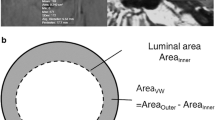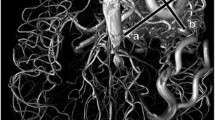Abstract
Background
Contrast-enhanced magnetic resonance angiography (CE-MRA) has become a very popular imaging technique in the evaluation of the extracranial vessels pathology, while it is not commonly used to rule out intracranial vascular pathology. On the contrary, 3D time of flight MRA (TOF-MRA) has a solid role in the study of intracranial arterial vessels disease.
Materials and methods
One hundred and eight patients were consecutively included in the study. All patients were submitted to a 3 Tesla 3D CE-MRA imaging to rule out extracranial vessels pathology. A comparison was made with a 3D-TOF sequence acquired at the same time in the assessment of intracranial vessels diseases such as steno-occlusion, dissection, and aneurysms.
Results
With regard to steno-occlusive disease, Spearman’s rank correlation coefficient was of 0.56 for stenosis detection and of 0.57 for occlusive disease detection. The two techniques shared similar results in the evaluation of anterior circulation, while 3D-TOF found higher grades of stenosis for posterior circulation. With regard to dissection, Spearman’s rank correlation coefficient was of 0.7. 3D-TOF depicted more intramural hematoma (Spearman’s rank = 0.46), while CE-MRA showed more pseudo-aneurysms (Spearman’s rank = 0.56). Both the technique equally evaluated the presence of intracranial aneurysms (Spearman’s rank = 1).
Conclusion
CE-MRA can be considered a reliable tool to rule out intracranial pathology associated to supraortic steno-occlusive disease, also allowing time reduction. In the suspicion of dissection a T1-weighted sequence has to be added to detect the presence of a subacute vessel wall hematoma.





Similar content being viewed by others
References
Campeau NG, Huston J 3rd. (2012 May) Vascular disorders--magnetic resonance angiography: brain vessels. Neuroimaging Clin N Am. 22(2):207–233
Randoux B, Marro B, Koskas F et al (2001) Carotid artery stenosis: prospective comparison of 0ct, three-dimensional gadolinium-enhanced mr, and conventional angiography. Radiology 220(2):179–185
Sundgren PC, Sunden P, Lindgren A et al (2002) Carotid artery stenosis: contrast-enhanced mr angiography with two different scan times compared with digital subtraction angiography. Neuroradiology 44(3):592–599
Alvarez-Linera J, Benito-Leon J, Escribano J et al (2003 May) Prospective evaluation of carotid artery stenosis: elliptic centric contrast-enhanced mr angiography and spiral ct angiography compared with digital. AJNR Am J Neuroradiol. 24(5):1012–1019
Weber J, Veith P, Jung B, Ihorst G, Moske-Eick O, Meckel S, Urbach H, Taschner CA (2015 Mar) MR angiography at 3 Tesla to assess proximal internal carotid artery stenoses: contrast-enhanced or 3D time-of-flight MR angiography? Clin Neuroradiol. 25(1):41–48
Anzalone N, Scotti R, Iadanza A (2006 Apr) MR angiography of the carotid arteries and intracranial circulation: advantage of a high relaxivity contrast agent. Neuroradiology. 48(Suppl 1):9–17
Platzek I, Sieron D, Wiggermann P et al (2014) Carotid artery stenosis: comparison of 3D time-of-flight MR angiography and contrast-enhanced MR angiography at 3T. Radiol Res Pract. 2014:508–715
Bachmann R, Nassenstein I, Kooijman H (2006) Spontaneous acute dissection of the internal carotid artery: high resolution magnetic resonance imaging at 3.0 tesla with a dedicated surface coil. Invest Radiol 41:105–111
Mehdi E, Aralasmak A, Toprak H (2018 Apr) Craniocervical dissections: radiologic findings, pitfalls, mimicking diseases: a pictorial review. Curr Med Imaging Rev. 14(2):207–222
Kidoh M, Nakaura T, Takashima H (2013 Feb) MR diagnosis of vertebral artery dissection: value of 3D time-of-flight and true fast imaging with steady-state precession fusion imaging. Insights Imaging. 4(1):135–142
Winn HR, Jane JA Sr, Taylor J et al (2002) Prevalence of asymptomatic incidental aneurysms: review of 4568 arteriograms. J Neurosurg 96:43–49
Héman LM (2009 Apr) Incidental intracranial aneurysms in patients with internal carotid artery stenosis: a CT angiography study and a metaanalysis. Stroke. 40(4):1341–1346
Coppenrath EM, Lummel N, Linn J (2013) Time-of-flight angiography: a viable alternative to contrast-enhanced MR angiography and fat-suppressed T1w images for the diagnosis of cervical artery dissection? Eur Radiol 23(10):2784–2792
Cirillo M, Scomazzoni F, Cirillo L (2013 Dec) Comparison of 3D TOF-MRA and 3D CE-MRA at 3T for imaging of intracranial aneurysms. Eur J Radiol. 82(12):e853–e859
Scarabino T, Carriero A, Giannatempo GM et al (1999) Contrast-enhanced MR angiography (CE MRA) in the study of carotid stenosis: comparison with digital subtraction angiography (DSA). J Neuroradiol 25:87–91
Aoki S, Nakajima H, Kumagai H, Araki T (2000) Dynamic contrast- enhanced MR angiography and MR imaging of the carotid artery: high-resolution sequences in different acquisition planes. AJNR Am J Neuroradiol 21:381–385
Ersoy H, Watts R, Sanelli P et al (2003) Atherosclerotic disease distri-bution in carotid and vertebrobasilar arteries: clinical experience in 100 patients undergoing fluoro-triggered 3D Gd-MRA. J Magn Reson Imaging 17:545–558
Riederer SJ, Stinson EG, Weavers PT (2018 Jan 10) Technical Aspects of Contrast-enhanced MR angiography: current status and new applications. Magn Reson Med Sci. 17(1):3–12
Korogi Y, Takahashi M, Nakagawa T et al (1997) Intracranial vas-cular stenosis and occlusion: MR angiographic findings. AJNR Am J Neuroradiol 18:135–143
Miyazaki M, Lee VS (2008 Jul) Nonenhanced MR angiography. Radiology. 248(1):20–43
Sadikin C, Teng MM, Chen TY (2007 Sep) The current role of 1.5 T non-contrast 3D time-of-flight magnetic resonance angiography to detect intracranial steno-occlusive disease. J Formos Med Assoc. 106(9):691–699
Hirai T, Korogi Y, Ono K, Nagano M, Maruoka K, Uemura S, Takahashi M (2002) Prospective evaluation of suspected steno-occlusive disease of the intracranial artery:combined MR angiography and CT angiography compared with digital subtraction angiography. AJNR Am J Neuroradiol 23:93–101
Oppenheim C, Naggara O, Touzé E (2009 Sep-Oct) High-resolution MR imaging of the cervical arterial wall: what the radiologist needs to know. Radiographics. 29(5):1413–1431
Author information
Authors and Affiliations
Contributions
Calloni Sonia Francesca: Contributed substantially to the acquisition of data, the analysis and interpretation- Drafted the manuscript.
Perrotta Marianna: conributed to the acquisition of data and the analysis.
Roveri Luisa: provided critical revision of the article. Provided final approval of the version to publish.
Panni Pietro: provided critical revision of the article and made a great contributions to the statistical analysis.
Del Poggio Anna: provided critical revision of the article.
Vezzulli Paolo Quintiliano: provided critical revision of the article.
Filippi Massimo: provided final approval of the version to publish.
Falini Andrea: Provided final approval of the version to publish.
Anzalone Nicoletta: Contributed substantially to the conception and design of the study, the acquisition of data, the analysis, and interpretation. Provided critical revision of the article. Provided final approval of the version to publish.
Corresponding author
Ethics declarations
Ethics approval
All procedures performed in studies involving human participants were in accordance with the ethical standards of the institutional and/or national research committee and with the 1964 Helsinki declaration and its later amendments or comparable ethical standards.
Conflict of interest
The authors declare no compeing interests.
Informed consent
Informed consent was obtained from all individual participants included in the study.
Additional information
Publisher’s note
Springer Nature remains neutral with regard to jurisdictional claims in published maps and institutional affiliations.
Rights and permissions
About this article
Cite this article
Calloni, S.F., Perrotta, M., Roveri, L. et al. The role of CE-MRA of the supraortic vessels in the detection of associated intracranial pathology. Neurol Sci 42, 5131–5137 (2021). https://doi.org/10.1007/s10072-021-05222-1
Received:
Accepted:
Published:
Issue Date:
DOI: https://doi.org/10.1007/s10072-021-05222-1




